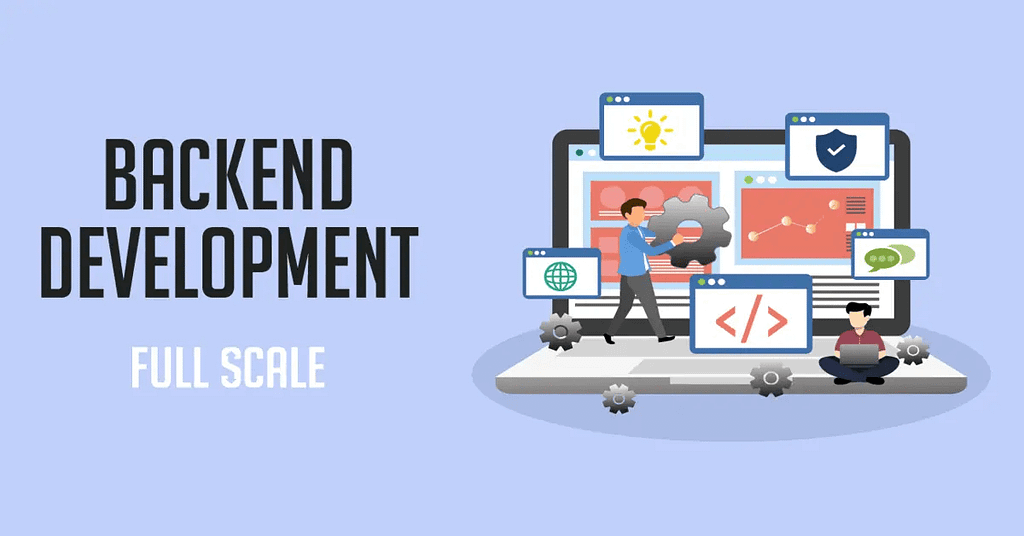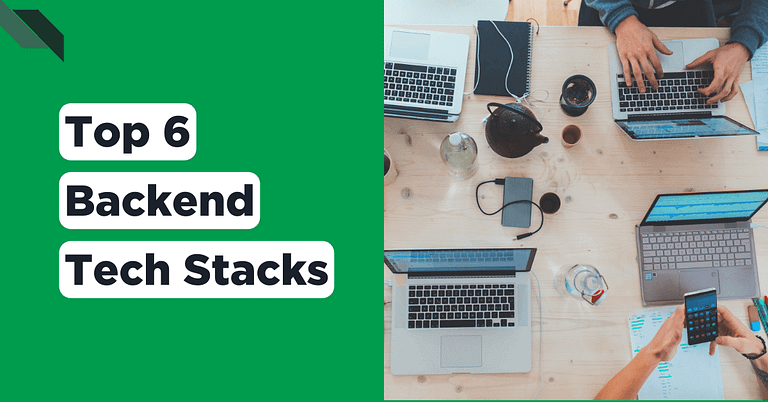Last Updated on 2025-01-22
What are the best backend tech stacks for software development? Learn about the most popular backend technologies.
The world of tech is always evolving. Businesses that engage in software development have to watch out for any updates or upgrades with the tools they’re using. It’s especially true for backend developers. To stay ahead of the game, they need to have proficiency when it comes to their libraries and frameworks.
Today, there are several promising backend tech stacks that can maximize the potential of software products. However, choosing a backend tech stack is not a straightforward process. There are many factors to consider, like the tool learning curve, market relevance, performance, and community support.
In this entry, we’ll look deeper into the most popular backend tech stacks and their pros and cons. But first, let’s have a refresher on what backend development is.
What Is Backend Development?
Backend development is the process of designing, modifying, and repairing the server-side component of a software application or website. It is the part of a system that most users do not see. It is a field that refers to the activities that occur behind the scenes when someone interacts with a website. A backend developer is someone who produces features that a user utilizes indirectly via the user interface.
The backend holds all the valuable data and enforces business and application logic. A well-designed product cannot compensate for poor performance. Aside from that, intelligent backend architecture and development stack enable the construction of complicated ecosystems and exquisite software solutions.
What Is A Backend Tech Stack?
A backend tech stack refers to the combination of technologies that run simultaneously behind the scenes of an application. They make up the engine that powers the entire system, ensuring it executes and delivers each task seamlessly.
Most Popular Backend Tech Stacks

1. Ruby on Rails
Ruby on Rails is a high-level, multipurpose, open-source backend framework developed in Ruby for online application development. Rails provides a default structure for a database, a web service, and web pages as an MVC (Model-View-Controller) framework. In addition to employing web standards (such as JSON and XML) for data transmission, the framework makes it possible to communicate with users using JavaScript, HTML, and CSS. The active record pattern, convention over configuration (CoC), and do not repeat yourself (DRY) are just a few of the well-known software engineering paradigms and patterns that Rails employs.
Ruby on Rails applications have a wide range of applications in web development. These applications include long-term projects requiring a significant number of transformations, projects with high traffic, and projects requiring complicated functionalities, among others. Companies that use Ruby on Rails include GitHub, Airbnb, and Ask.FM, as well as Basecamp, Goodreads, MyFitessPal, Shopify, and Twitter.
2. Node.js
Node.js is a server-side runtime that allows JavaScript to run across the entire system. It allows users to run JavaScript natively on servers, paving the path for the development of JavaScript APIs. Now, Express.js is a Node.js web application framework that can help you create a backend service with a high level of abstraction. MongoDB is a prominent document-based NoSQL database.
One of the most significant advantages of this tech stack is its popularity and abundance of resources. This allows developers to learn quickly and easily. There are also numerous work options. Because Node.js is asynchronous, it provides a highly beautiful event loop-based approach for request processing that performs incredibly well.
The main disadvantage of this framework, however, is the way Node.js is built. Node.js is computationally slow and not suitable for intense operations on the backend. Overall, it is a comprehensive tech stack that is used by various industry heavyweights such as LinkedIn, Uber, and Netflix, as well as several startups.
3. CakePHP
CakePHP is an open-source web framework developed in PHP that is based on the MVC (model-view-controller) architecture pattern. CakePHP makes use of several well-known software engineering paradigms and design patterns, such as convention over configuration, active record, front-end control, and association data mapping. This framework simplifies the development, deployment, and maintenance of apps.
CakePHP is ideal for rapid application development (RAD), allowing you to swiftly and consistently implement your concept. CakePHP allows you to construct your concept in weeks rather than months. Fujitsu, Deloitte, Swat.io, Quezx.com, Glen Raven Inc., Walls.io, NetSapiens Inc., InSync Solutions, and others are among the top CakePHP users.
4. Python-Django
Python is a programming language that has received extensive use over the years in a variety of fields like Artificial Intelligence, Security, Backend Development, and others. It is one of the easiest programming languages to learn. Thousands of tutorials and simple syntax make the learning curve quite short.
Django is one of the top Python web development frameworks, and when combined with PostgreSQL, it forms one of the best tech stacks available. There are also numerous work options. One of the most significant advantages is that Django is a complete framework in and of itself, with a fantastic ORM. Django’s development speed is quite rapid, which is especially useful when there is a tight deadline.
It is recommended to use Django Dashboard Template while working on Django project to speed up the development process.
However, because its ORM is not asynchronous, response times are slower. It is also memory-heavy, which might be a problem at times. Django also abstracts out a number of procedures that are important for better understanding backend programming. Overall, it is a good pick for a technology stack.
5. Laravel
Laravel is a well-known open-source backend tech stack framework based on the MVC architecture. It is a PHP framework noted for its clean syntax, flexibility for big teams, and current toolkit features. Furthermore, its distinct syntax provides developers with a high level of flexibility and creativity while handling all backend operations. Laravel provides an attractive user interface, API support, and numerous frameworks to help developers create modern and secure web applications.
Laravel supports many PHP features, such as interfaces, overloading, namespaces, simplified array syntax, and anonymous methods. A website built with Laravel is also safe and resistant to a variety of web threats. 9GAG, Crowdcube, Razorpay, 9GAG, Pfizer, BBC, PedidosYa, Ratio, About you., TourRadar, Lenovo, and others are among the top firms that use Laravel.
6. Python-FastAPI
FastAPI’s best feature is its speed, which is faster than practically all frameworks on the market. It is asynchronous by default, has built-in request body validation, and can be utilized with a laughably tiny amount of code. It is also quite useful for deploying Python-coded Machine Learning models. When this is used with any open-source ORM to connect it to PostgreSQL, you’ll have an extremely performant, robust, and production-ready tech stack.
The only disadvantage with this backend tech stack is that the framework is somewhat old. It is not as popular as Javascript tech stacks that are more up-to-date and have a larger support community. It’s also not as easy to find developers who specialize in this particular tech stack.
It’s Important to Find the Right Backend Tech Stack
Choosing the right backend tech stack can be challenging. Before choosing a tech stack, identify all the goals and priorities of the project. There are several things to consider, including individual preferences, project deadlines, market timing, project complexity, budgets, and future-oriented support.
Final Tip: Finding Backend Developers
The success of backend development will heavily depend on the skills and experience of your team. Hiring backend developers can be hard, especially with the ongoing IT talent shortage. Businesses are having a hard time filling in their talent gaps for projects that use specific technologies. Backend developers, like all other IT positions, are difficult to find.
Fortunately, there are now more options to widen the talent pool. Full Scale assists firms in expanding their search offshore and provides services for hiring and managing professionals abroad. Consider outsourcing with Full Scale if you want to locate employees with the right talent and expertise for your project.
Hire Backend Developers with Full Scale
Start your software development journey with Full Scale. We are a software outsourcing company that provides software development solutions to businesses. Our goal is to connect you with the best IT experts in the field. We’ll match you with seasoned software developers, QA testers, project managers, and marketing professionals.
Go to our website to kickstart your software development project! It only takes a few minutes to navigate our client dashboard to find the particular sort of software development resource you desire.
Contact us today!

Matt Watson is a serial tech entrepreneur who has started four companies and had a nine-figure exit. He was the founder and CTO of VinSolutions, the #1 CRM software used in today’s automotive industry. He has over twenty years of experience working as a tech CTO and building cutting-edge SaaS solutions.
As the CEO of Full Scale, he has helped over 100 tech companies build their software services and development teams. Full Scale specializes in helping tech companies grow by augmenting their in-house teams with software development talent from the Philippines.
Matt hosts Startup Hustle, a top podcast about entrepreneurship with over 6 million downloads. He has a wealth of knowledge about startups and business from his personal experience and from interviewing hundreds of other entrepreneurs.





